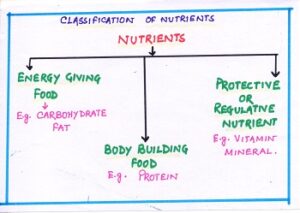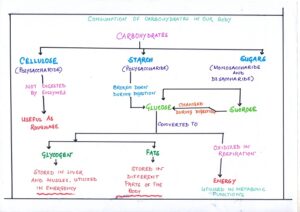TYPES OF NUTRITION
INTRODUCTION: Nutrition is the process of providing or obtaining necessary food materials consisting of essential inorganic and organic compounds like proteins, vitamins etc. for growth, maintenance and survival. The food material carry nutrients in them. A nutrient is an organic or organic chemical substance which nourishes our body. A nutrient supplies energy to the body, builds and repairs body tissues and regulators of body processes. Our food nourishment contains numerous supplements like starches (carbohydrates, fats, proteins, l essential nutrient (vitamins) minerals, salts water and roughage. Nourishment is a substance containing supplements that we eat or drink in mode of nutrition.
WHY IS NUTRITION ESSENTIAL
The food is essential for us in mode of nutrition because
- Food provides enegy to perform life activities.
- Food is necessary for growth of living organism.
- Foos is used to synthesize new protoplasm for repair and replacement of worn out cells.
- Food provides raw materials for the synthesis of enzymes and
- Food gives vitamins and minerals for protection against infection and diseases.
ENERGY REQUIREMENTS OF THE BODY IN MODE OF NUTRITION
Energy is needed for the maintenance of body tissues and body temperature, for growth, for physical and mental activities, protection from disease and infections and also for reproduction.
The vitality of nourishment prerequisite mainly relies upon age, sex and nature of work.
CLASSIFICATION OF NUTRIENTS

Nutrients are classified on the basis of their functions. Both organic and inorganic constituents of food are classified into three groups in mode of nutrition.
- ENERGY-GIVING NUTRIENTS:
Carbohydrates and fats are main energy-yielding nutrients. They release energy on oxidation. Cereals, sugars,potatoes,rice are rich sources of carbohydrates.
Fats serve as emergency depots of energy in the body. They are stored in adipose tissues and provide almost double the amount of energy as released by same amount of carbohydrates. Animal fats and vegetable oils are the sources of fat. (FOOD AND NUTRITION)
- BODY-BUILDING NUTRIENTS
Proteins are body-building components of food. They are used in the synthesis of protoplasm. The new living matter is used in
- Replacing the worn out components of cell and body (repair of cell).
- Increasing the cell size and body growth (cell growth).
- Increasing the number of cells by cell division (cell multiplication).
- Formation of new cell types (cell differentiation)
Thus, proteins are used foe building muscles, bones and blood cells in mode of nutrition. They are used as energy source in case of not meeting energy by body by carbohydrate and fats. Milk, egg, meat, fish, liver, pulses, beans are protein-rich food.
- PROTECTIVE OR REGULATIVE NUTRIENTS (energy giving food)
Vitamins and minerals are protective and regulative food. They are needed in small quantities. Their shortage or deficiency in the body cause diseases or deficiency symptoms. Green vegetables, fruits and milk are sources of vitamin and mineral. (FOOD AND NUTRITION)
ESSENTIAL COMPONENTS OF FOOD
1)CARBOHYDRATES- the energy source
Carbohydrates are energy giving organic compounds. They are formed of carbon, hydrogen and oxygen in the ratio 1:2:1. In each moleclule of carbohydrate, hydrogen and oxygen occur in the same ratio as in water (2:1). Hence, these compounds are additionally called hydrates of carbon.

FUNCTIONS OF CARBOHYDRATES
- One gram of carbohydrates on oxidation releases about 17 kilojoules or 4.1 kilocalories of energy.
- Carbohydrates are stored in the body as glycogen in animal and as starch in plants.
- Cellulose forms cell wall in plant cell.
- Ribose and Deoxyribose are components of nucleic acid.
2) FATS AND OILS – THE FOOD RESERVE
Like sugars( starch) fats likewise contain carbon, hydrogen and oxygen ,yet opposite yets from starches in that fats contain more carbon and hydrogen and less oxygen. Fats are insoluble in water but soluble in solvents like Acetone, Benzene, and Chloroform.
SOURCES OF FATS: Butter, ghee, cheese, cooking oils like groundnut oil, coconut oil, mustard oil, milk, egg yolk, meat, nuts and soyabean yield fat type of food . The fats which we eat in our diet are called dietary fats.
TYPES OF FATS: There are two types of fats saturated and unsaturated. ( energy giving food)
- Most animal fats remain solid at room temperature because they have high melting point. they are called saturated because they are formed of saturated fatty acids . Butter, ghee, meat, egg-yolk, milk are containing saturated fats.
- Plant fats are unsaturated fats. This remains fluid at room temperature because they are formed of unsaturated fatty acids and therefore, have a low melting point. they are called oils. Examples are mustard oil, groundnut oil, til oil, sunflower oil, sesame oil, bran oil, cottonseed oil, eucalyptus oil. ( protective or regulative nutrients)
FUNCTIONS OF FATS
- Fats are ideal for storage in the body.
- The layers of fatty tissues or adipose tissues form a shock-absorbing cushion around the vital organs.
- Fats are structural components of cytomembranes and plasma membranes along with the proteins.
- Some fatty compounds act as female sex-hormones such as
- Fats help in the absorption of fat-soluble vitamins like A, D, E, K.
3)PROTEINS—THE BODY-BUILDING MATERIAL ( protective or regulative nutrients)
Proteins are body-building organic molecules. Carbon, hydrogen, oxygen and nitrogen form protein molecules. In addition, Sulphur is found in all plants and some animal proteins. Phosphorus is present in nucleoproteins. Protein molecule are gigantic and extremely complex macro-molecules. These are polymers of amino acid units. In a protein macro-molecule, hundreds of amino acids (monomers) are linked by peptide bonds. Twenty different types of amino acids join in various combinations and produce numerous varieties of proteins.
FUNCTIONS OF PROTEINS:
AMINO ACID
- It acts as structural components of body (AMINO ACID).
- It helps in building and maintaining body tissue where amino acids are making units of polypeptides.
- Many proteins act as enzymes (AMINO ACID).
- Some proteins other than amino acid act as hormones .
- Some proteins act as antibodies which protect the body form antigen or foreign materials (AMINO ACIDS).
- Protective proteins help to fight against infection as WBC other than amino acid.
- Some proteins help in transportation of materials like haemoglobin carries oxygen. (AMINO ACID)
PROTECTIVE NUTRIENTS—VITAMIN AND MINERALS (AMINO ACID)
| VITAMINS/ MINERALS | SOURCES | DEFICIENCY DISEASE |
| Vit A | Milk, cream, yellow fruits like carrots, mangoes | Nightblindness or xerophthalmia |
| Vit D | Milk , butter, sunlight cod liver oil, egg | Rickets or osteomalacia |
| Vit E | Egg yolk, cereals, liver, milk, butter, wheat germ oil. | Fertility disorders |
| Vit K | Green leafy vegetables, soyabean, tomatoes | Delayed blood clotting and haemorrhage. |
| Vit B1 | Milk, seafood, meat, whole grain. | Beriberi |
| Vit B2 | Milk, pea, bean,egg. | Ariboflavinosis. |
| Vit B3 | Peanuts, meat, liver, tomato, potato | Pellagra |
| Vit B9 | Sprouted pulses, green leafy vegetables | Anaemia |
| Vit B12 | Egg, liver , meat, milk | Pernicious anaemia |
| Vit C | Orange, amla, lemon, guava, tomato, cabbage | Scurvy |
| Sodium | Common salt, sea food | Cramps due to dehydration contraction |
| Potassium | Green vegetables, fruits | No deficiency disease |
| Calcium | Milk, cheese, egg, fruits | Rickets |
| Phosphorous | Fish, egg, milk leafy vegetables | Body weakness |
| Iron | Meat, beans, cabbage, apple | Anaemia |
| Chlorine | Common salt, sea-food | No deficiency disease |
| Iodine | Drinking water, sea-food, rock salt. | Simple goitre |
A balanced diet is one which provides all the nutrients i.e. carbohydrates, fats, proteins, vitamins, minerals, water and roughage required by our body in correct proportion for its normal maintenance (AMINO ACID)
NUTRITIVE VALUE OF BALANCED DIET (amino acid)
If a balanced diet consists of 3,000 calories for normal person then his diet must contain—
(AMINO ACID)
- 90 gm protein for growth and repair.
- 90 gm fat and 450 gm carbohydrates for energy.
- Vitamins and minerals for metabolic activities.
- Water (2.5 – 3 litre) for digestion and excretion.
- Roughage for proper bowel movement.
